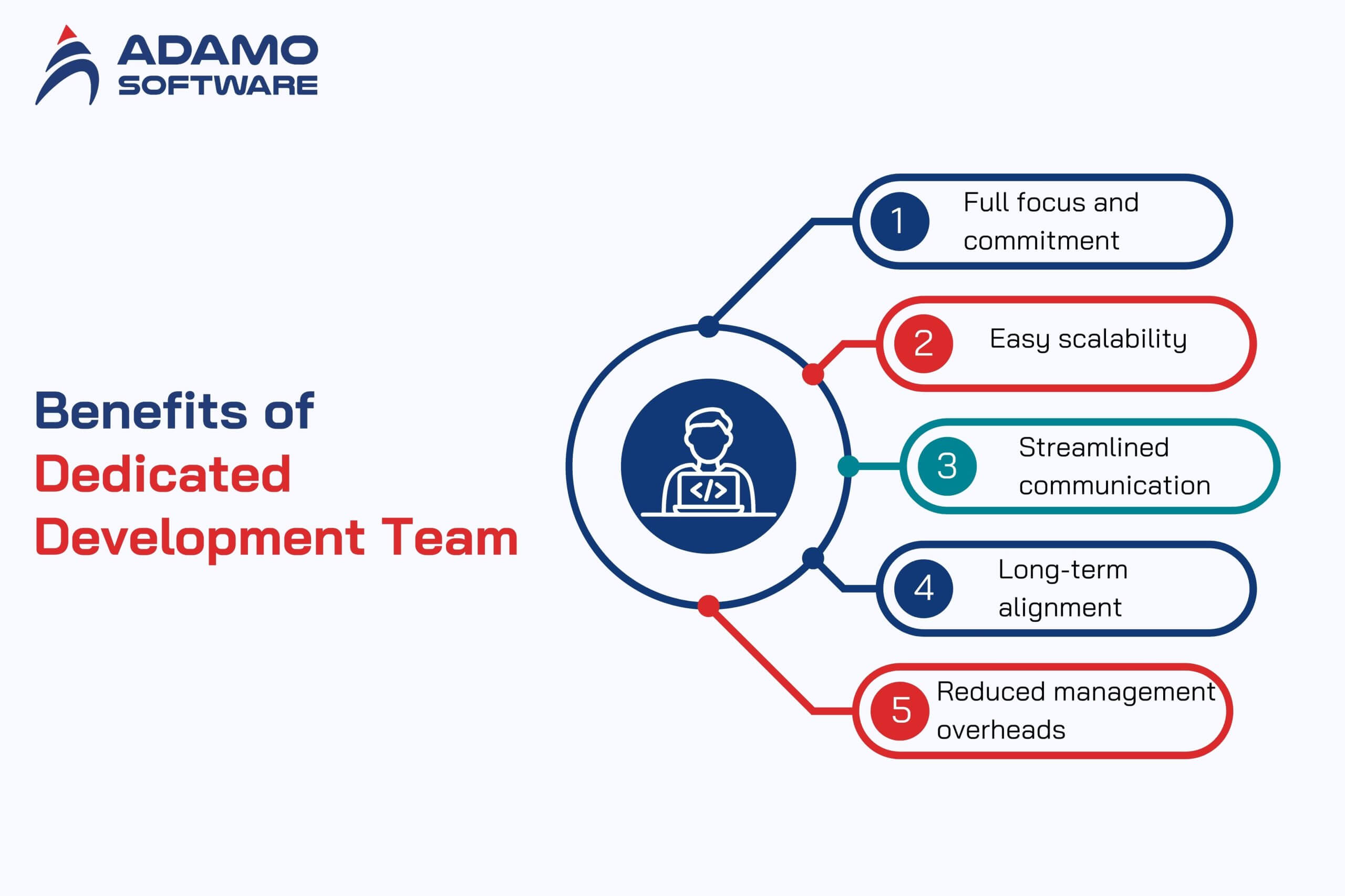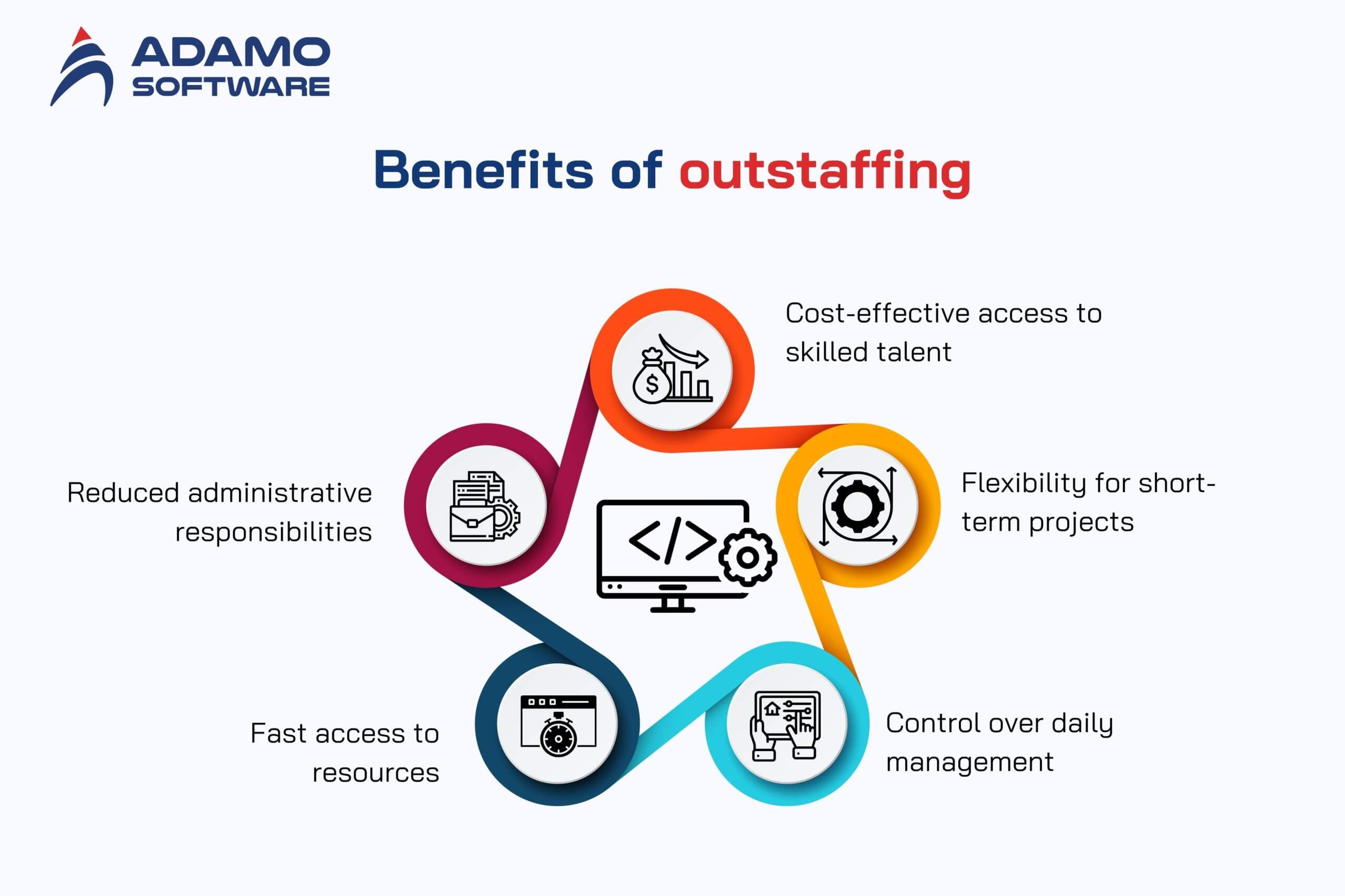Dedicated development team vs outstaffing: What’s the difference?

In the modern world of software development, companies have to choose between having a development team and outstaffing. Each of them has its advantages, and this is why the definitions of both models should be comprehensively elaborated. They are individuals employed with a specific client organization that has hired a dedicated development team to work only on its projects. Meanwhile, outstaffing allows businesses to rent in a single specialist or a group of developers for certain distinct purposes. However, these specialists still work as employees for a third-party company.
Dedicated development team vs outstaffing makes all the difference in a project’s success. Each model has its advantages. For example, the dedicated team model can have deep cooperation. It is completely different from the outstaffing model, which has a great advantage in flexibility and relatively low costs. These differences can be further elaborated to aid business decision-making. They carry out endeavors that are relevant to the intended goals and available capital.
This article will aim to briefly review the principles, advantages, and differences between the two solutions. You will understand why many organizations choose professional services from Adamo – the dedicated team model.
I. Dedicated development team vs outstaffing: Definition
1. What is a dedicated development team?
When a company wishes to have a team of software developers to attend to their requirements, it is referred to as a dedicated development team. The reason is that it comprises well-trained and professional personnel from a third-party firm. Most members of this team are developers, designers, testers, and project managers. They attend only to the problems of a single client for some time. The client has full control over who to include in the team and who will work with your company’s goals. In this case, the team works like an internal team, becoming a part of the client’s processes and overall mission.
One advantage of a dedicated development team is to design a larger workforce without concern for how to hire them. This model is suitable for predictable projects that will take a long time to complete. Because there might be changes in the goals as the project progresses. The new requirements can be addressed without having to get new people onto the team.
This model of development gives high outsourcing seriousness while at the same time giving the client very tight control of the whole process. Therefore, it eliminates these overhead costs of recruitment for the fully committed development team. Hence, the dedicated development team vs outstaffing issue can be a function of how much control and integration clients want.
2. What is Outstaffing?
Outstaffing is another model for cooperation between the client’s team and external specialists. Outstaffing performs individual employees or several of them who can meet the key requirements needed in the particular work. The given professionals stay a part of the vendor’s team, yet they work within the client’s directions and their groups. The client supervises the project, assigning work and assessing performance. At the same time, the vendor takes on the responsibility of managing payrolls and other employee privileges.
Outstaffing is most useful for those scenarios when a business wants to gain specific expertise for a short while. For example, during a surge of the project or when there is a gap in the competencies of the internal team. Outstaffing also means that in a short time organizations and companies can gain access to certain skills they lack. The latter is chosen for shorter periods. When the project is not as complicated and is unlikely to have many changes in the future.
The choice between having a dedicated development team and outstaffing depends on such conditions as project length, needed expertise, and cooperation degree needed.
Also read: Dedicated team vs Project-based outsourcing: Tips to choose
II. Benefits of choosing a dedicated development team and outstaffing
Comparing the dedicated development team model and outstaffing, distinguish the strengths of each option that will suit a particular type of business. Therefore, organizations can choose a method offering a better fit for the goal, affordable cost, and the human resources available.
Benefits of a Dedicated Development Team

1. Full Focus and Commitment: A dedicated development team works on a particular client’s project. Thus, they are fully involved and knowledgeable of the project needs. This is usually the case. The focus is placed on giving quality work, especially when the project entails several years of work.
2. Easy Scalability: Due to its high degree of formality, organizations can flexibly staff up or down a dedicated team depending on the project’s needs. They can also hire more people with certain skills if necessary. This capability is relevant for organizations that expect the scale of their work, or specific tasks’ definition, to evolve in the future.
3. Streamlined Communication: In the dedicated development team model, the team members are integrated into the client’s in-house team. This helps to facilitate communication and to keep everyone on the same page in terms of the project objectives. The client can even communicate with the team daily, meaning that they will understand the team’s progress.
4. Long-Term Alignment: A dedicated development team is usually committed to the project for quite a long time. Therefore, they build more profound insights into the client’s business strategies, requirements for the product, and further goals. This alignment allows them to provide clients with solutions that may serve their intermediary and strategic goals and objectives.
5. Reduced management overheads: With dedicated resources, the vendor assumes administrative and HR duties. The client directs work on the project management level instead of daily involvement in HR activities. Such a structure makes overall management easier and reduces the time spent by the client.
Benefits of outstaffing

1. Cost-Effective Access to Skilled Talent: Outstaffing is a relatively cheap means of sourcing skills while avoiding the need to offer full-time employment. Employers can hire certain candidates for any number of hours to increase efficiencies while not overpaying for great minds.
2. Flexibility for Short-Term Projects: Outstaffing is most suitable for short-term intervals or one-shot projects. It is also helpful when the company does not need several specialists for permanent collaboration but needs professionals occasionally. Overburdened staff can be supplemented, vacancies can be filled, or there can be work that is best handled by specific expertise. Professionals can indeed step in from an outstaffing service.
3. Control Over Daily Management: In the outstaffing model, the client has even full authority over the outstaffed team members – assigns the tasks, prioritizes them, and oversees the results. This model is suitable for an organization with proper internal infrastructure that seeks a sufficient level of management control.
4. Fast Access to Resources: Outstaffing also makes it possible for businesses to scale up their teams without the time it takes to look for talent in the market. This speed is suitable for one when they have a quickly progressing project or when in-house teams need assistance.
5. Reduced Administrative Responsibilities: Outstaffed workers are operated under the management of the client. However, all issues related to hiring and firing and contract signings fall under the purview of the vendor. It also removes the burden of all the HR roles so that onboarding becomes faster and more efficient for the client.
Outstaffing or the dedicated development team can be chosen based on the project and timeframes for its implementation. Establishments with constantly developing large-scale tasks are better provided by a dedicated team for stability and completeness. Establishments that have acute, clear, well-defined needs find outstaffing’s flexibility and swift delivery to be perfect for their needs. Therefore, both approaches present special modes to attract qualified personnel and optimize processes of work. This makes a dedicated development team vs outstaffing one of the significant issues, based on the integration of modern technologies.
III. What are the differences between a dedicated development team vs outstaffing?
Here’s the table reflecting the main distinctions between the dedicated development team and outstaffing models. By identifying characteristics such as management, the composition of the team, the time required for the implementation of work, and control, businesses can understand which model is better to work with. The need to compare both models of cooperation is important. Each carries benefits depending on the specific project and company objectives.
| Aspect | Dedicated Development Team | Outstaffing |
| Definition | A dedicated development team is a full team provided by a vendor to work solely on a client’s project. | Outstaffing provides specific individual professionals who join the client’s in-house team as needed. |
| Team Structure | A complete team, often including developers, designers, and project managers, tailored to the client’s needs. | Individual professionals with specific skills are added to the client’s existing team for support. |
| Project Duration | Best suited for long-term projects that require a stable and focused team over time. | Ideal for short-term tasks, peak project phases, or filling temporary skill gaps. |
| Management and Control | The client manages the project goals and workflow, while the vendor handles HR and administrative tasks. | The client maintains full daily management of the outstaffed professionals, who work under client supervision. |
| Integration | The team integrates deeply with the client’s processes and becomes an extension of the in-house team. | Outstaffed workers integrate into the team but may remain more separate, especially for short-term needs. |
| Scalability | High scalability; the team size and roles can be adjusted as project needs evolve. | Flexible but limited to scaling specific roles or skills instead of adding a whole team. |
| Cost Efficiency | Cost-effective for longer projects as it reduces hiring and management overheads. | Often more cost-effective for short-term needs since only specific roles are filled temporarily. |
| Administrative Responsibility | Vendor handles contracts, payroll, and benefits, reducing client HR responsibilities. | The vendor covers administrative aspects, though the client takes on more day-to-day management responsibilities. |
| Level of Commitment | High commitment, as the team focuses only on the client’s project. | Lower commitment, with professionals working as support within an existing team, often temporarily. |
Selection between a dedicated development team and an outstaffing option depends on factors such as the length of the project, the need for specialized skills, and management styles. The dedicated development team vs outstaffing comparison helps businesses decide whether they prefer working with an external team.
IV. Why businesses choose Adamo’s dedicated team model

In deciding between dedicated development teams and outstaffing, clients often choose the dedicated team model, which is offered by Adamo Company. Adamo appoints project teams that are exclusively dedicated to that particular project. Therefore, understand well the intentions of the project and how best to address any changes. It makes the business perfect for those who need long-term and committed employees without facilitating the human resource personnel.
Adamo’s model allows clients comprehensive control over project deliverables, and the vendor controls recruitment, payroll, and contracts. For those looking at a dedicated development team vs outstaffing, Adamo’s strategy provides the clients with dedicated staff with easy control of the operation process.











